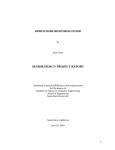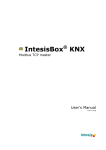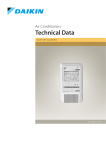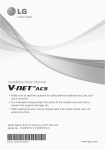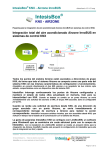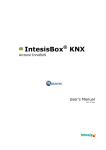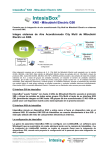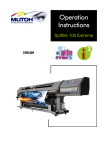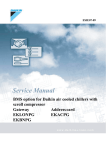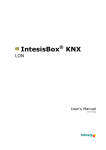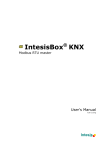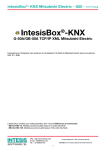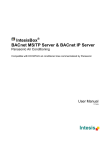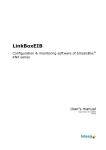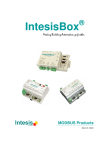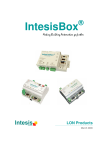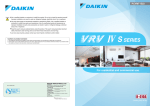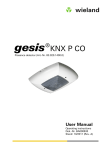Download KNX - BACnet/IP Client User`s manual v10 r10 eng
Transcript
® IntesisBox KNX BACnet/IP Client User's Manual v10 r10 eng IntesisBox® KNX - BACnet/IP Client © Intesis Software S.L. User's manual v10 r10 eng All Rights Reserved. Information in this document is subject to change without notice. The software described in this document is furnished under a license agreement or nondisclosure agreement. The software may be used only in accordance with the terms of those agreements. No part of this publication may be reproduced, stored in a retrieval system or transmitted in any form or any means electronic or mechanical, including photocopying and recording for any purpose other than the purchaser’s personal use without the written permission of Intesis Software S.L. Intesis Software S.L. Milà i Fontanals, 1 bis - 1º 08700 Igualada Spain TRADEMARKS All trademarks and tradenames used in this document are acknowledged to be the copyright of their respective holders. Doc: IntesisBox KNX - BACnet IP Client V10 r10 eng.pdf © Intesis Software S.L. - All rights reserved IntesisBox is a registered trademark of Intesis Software SL URL email tel http://www.intesis.com [email protected] +34 938047134 Page 2 of 39 IntesisBox® KNX - BACnet/IP Client User's manual v10 r10 eng Gateway for the integration of BACnet/IP based systems or devices with KNX TP-1 (EIB) control systems. Two models are available for this gateway, with the following Order Codes: IBOX-KNX-BAC-A Basic model supporting integration of up to 1 BACnet device and 500 datapoints. IBOX-KNX-BAC-B Extended model supporting integration of up to 16 BACnet devices and 4000 datapoints. Doc: IntesisBox KNX - BACnet IP Client V10 r10 eng.pdf © Intesis Software S.L. - All rights reserved IntesisBox is a registered trademark of Intesis Software SL URL email tel http://www.intesis.com [email protected] +34 938047134 Page 3 of 39 IntesisBox® KNX - BACnet/IP Client User's manual v10 r10 eng INDEX 1. Description ..................................................................................................... 5 1.1 Introduction ................................................................................................ 5 1.2 Functionality................................................................................................ 6 1.3 Capacity of IntesisBox .................................................................................. 7 2. KNX System ................................................................................................... 8 2.1 Description .................................................................................................. 8 2.2 Points definition ........................................................................................... 9 3. BACnet interface of IntesisBox ........................................................................ 10 3.1 Description ................................................................................................ 10 3.2 Points definition ......................................................................................... 11 4. LinkBoxEIB. Configuration & monitoring tool for IntesisBox KNX series................. 12 4.1 Introduction .............................................................................................. 12 4.2 Project definition ........................................................................................ 12 4.3 Connection configuration............................................................................. 17 4.4 Signals configuration .................................................................................. 21 4.4.1 Remember ............................................................................................. 25 4.4.2 Restrictions ............................................................................................ 25 4.5 Saving the configuration and sending it to IntesisBox ..................................... 26 4.6 Signals viewer ........................................................................................... 27 4.7 System commands ..................................................................................... 28 4.8 Files ......................................................................................................... 29 5. Setup process and troubleshooting .................................................................. 30 5.1 Pre-requisites ............................................................................................ 30 5.2 Setup procedure ........................................................................................ 30 6. Connections .................................................................................................. 33 7. BACnet/IP interface specifications.................................................................... 34 8. Mechanical & electrical characteristics .............................................................. 35 9. Dimensions................................................................................................... 36 10. Annexes ....................................................................................................... 37 10.1 Integration of DAIKIN VRV air conditioning systems with KNX.......................... 37 10.1.1 Daikin DMS502B51 BACnet Gateway for Daikin A.C. VRV system............... 38 10.1.2 Specific LinkBoxEIB projects for this application. ..................................... 39 10.1.3 Requirements to configure the integration .............................................. 39 Doc: IntesisBox KNX - BACnet IP Client V10 r10 eng.pdf © Intesis Software S.L. - All rights reserved IntesisBox is a registered trademark of Intesis Software SL URL email tel http://www.intesis.com [email protected] +34 938047134 Page 4 of 39 IntesisBox® KNX - BACnet/IP Client User's manual v10 r10 eng 1. Description 1.1 Introduction This document describes the integration of KNX TP-1 (EIB) systems with BACnet ASHRAE 135 – 2001 Annex J - BACnet/IP protocol compatible devices or systems using the gateway IntesisBox KNX - BACnet/IP client. This document assumes that the user is familiar with KNX and BACnet technology and technical terms. From now on, and with the aim of easy the read of this document, just the word "IntesisBox" will be used instead of the full gateway model description "IntesisBox KNX BACnet/IP client". The aim of this integration is to make accessible signals and resources of any BACnet/IP based system or device (for example Daikin VRV AC system) from any KNX TP-1 (EIB) control system. For this, IntesisBox acts as a BACnet/IP Client device in its BACnet interface, reading/writing points of other BACnet/IP device(s), and offering this point's values of BACnet device(s) through its KNX interface, acting in the KNX system as one more KNX device of the system. The readings of the BACnet device(s) performed by IntesisBox can be by polling or by subscription (COV). BACnet IP device KNX EIB Bus KNK EIB BACnet IP Ethernet IntesisBox LAN TCP/IP BACnet IP device RS232 LinkBoxEIB Configuration Software Only needed for configuration Integration of BACnet and KNX using IntesisBox KNX - BACnet/IP client gateway Doc: IntesisBox KNX - BACnet IP Client V10 r10 eng.pdf © Intesis Software S.L. - All rights reserved IntesisBox is a registered trademark of Intesis Software SL URL email tel http://www.intesis.com [email protected] +34 938047134 Page 5 of 39 IntesisBox® KNX - BACnet/IP Client 1.2 User's manual v10 r10 eng Functionality The integration operation is as follow: From the BACnet system point of view, after the start up process, IntesisBox reads continuously the points configured to be read by polling and also performs all the subscriptions (COV) requests for points configured to be read by subscription, and updates in its memory all the values received from the BACnet system. Every one of the mentioned BACnet points is associated to a KNX group address, with this, all the BACnet system is seen as one more KNX device from the KNX system point of view, with the same configuration and operation characteristics. When a change in any BACnet point occurs, a write telegram can be sent to the KNX bus, of the associated KNX Group. This is configurable per point, using the KNX flags available individually per every point in IntesisBox and freely configurable. See details in section 4. When a telegram is received from the KNX bus, of a KNX Group address associated to a BACnet point, a message is sent immediately to the corresponding BACnet device to perform the corresponding action. In the continuous polling of the BACnet devices, if a non response of the BACnet device is detected, the corresponding virtual signal inside IntesisBox will be activated indicating communication error with the BACnet device. (A "keep alive" message is used for this purpose for those BACnet devices using COV subscriptions instead of continuous polling). These virtual signals indicating communication status in real time with the BACnet devices are also accessible from KNX, like the rest of the points of IntesisBox. Doc: IntesisBox KNX - BACnet IP Client V10 r10 eng.pdf © Intesis Software S.L. - All rights reserved IntesisBox is a registered trademark of Intesis Software SL URL email tel http://www.intesis.com [email protected] +34 938047134 Page 6 of 39 IntesisBox® KNX - BACnet/IP Client 1.3 User's manual v10 r10 eng Capacity of IntesisBox Element Max.* (basic version) Max.* (extended version) Type of BACnet devices Number of BACnet 1 devices Number of BACnet points 500 Notes Only those supporting BACnet/IP. 16 4000 Maximum number of BACnet devices accepted by IntesisBox. Maximum number of points that can be defined in IntesisBox. *These maximum values can be extended on demand There are two different models of IntesisBox® KNX - BACnet/IP Client, with different capacity every one of them. • Basic model supporting connection to up to 500 internal data points and 1 BACnet device. Ref.: IBOX-KNX-BAC-A. • Extended model supporting connection to up to 4000 internal data points and 16 BACnet devices. Ref.: IBOX-KNX-BAC-B. Doc: IntesisBox KNX - BACnet IP Client V10 r10 eng.pdf © Intesis Software S.L. - All rights reserved IntesisBox is a registered trademark of Intesis Software SL URL email tel http://www.intesis.com [email protected] +34 938047134 Page 7 of 39 IntesisBox® KNX - BACnet/IP Client User's manual v10 r10 eng 2. KNX System In this section, a common description for all IntesisBox KNX series gateways is given, from the point of view of KNX system which is called from now on internal system. The BACnet system is also called from now on external system. 2.1 Description IntesisBox KNX connects directly to the KNX TP-1 (EIB) bus and behaves as one more devices into the KNX system, with the same configuration and operational characteristics as other KNX devices. Internally, the circuit part connected to the KNX bus is opto-isolated from the rest of the electronics. IntesisBox KNX receives, manages and sends all the telegrams related to its configuration to the KNX bus. On receiving telegrams of KNX Groups associated to the external system (BACnet in this case), the corresponding messages are sent to the external system to maintain both systems synchronised in every moment. When a change in a signal of the external system is detected, a telegram is sent to the KNX bus (of the associated KNX group) to maintain both systems synchronised in every moment. The status of the KNX bus is checked continuously and, if a bus drops down is detected, due to a failure in the bus power supply for example, when the KNX bus is restored again, IntesisBox will retransmit the status of all the KNX groups marked as "T" Transmit. Also the Updates of the groups marked as "U" Update will be performed. The behaviour of IntesisBox for every point is determined by the flags configured individually per every point, which are freely configurable. See details in section 4. Doc: IntesisBox KNX - BACnet IP Client V10 r10 eng.pdf © Intesis Software S.L. - All rights reserved IntesisBox is a registered trademark of Intesis Software SL URL email tel http://www.intesis.com [email protected] +34 938047134 Page 8 of 39 IntesisBox® KNX - BACnet/IP Client 2.2 User's manual v10 r10 eng Points definition Every signal of the external system (BACnet) to use has the following KNX properties: Property Signal Description Signal's Description. Only for informative purposes, allows identifying the signal comfortably. EIS (Datapoint) It is the KNX data type used to code the signal's value. It will depend on the type of signal associated in the external system in every case. In some integration it is selectable, in others it is fixed due to the intrinsic characteristics of the signal. Group It is the KNX group to which the signal is associated. It is also the group to which the read (R), write (W), transmit (T) and update (U) flags are applied. Is the sending group. Listening They are the addresses that will actuate on the signal, apart of the Group addresses address. R Read flag. If activated, read telegrams of this group will be allowed. W Write flag. If activated, write telegrams of this group will be allowed. T Transmit flag. If activated, when the signal's value changes, due to a change in the external system, a write telegram of the group will be sent to the KNX bus. U Update flag. If activated, on IntesisBox start-up or after a KNX bus reset detection, read telegrams of the sending group will be sent to the KNX bus, and the value received will be sent to the external system as if it has been received by a write telegram. Active If activated, the signal will be active in IntesisBox; if not, the behaviour will be as if the signal is not defined. Allows deactivating signals without the need of delete them for possible future use. These properties are common for all IntesisBox KNX series gateways, although every integration may have specific properties according to the type of signals of the external system in every case. Doc: IntesisBox KNX - BACnet IP Client V10 r10 eng.pdf © Intesis Software S.L. - All rights reserved IntesisBox is a registered trademark of Intesis Software SL URL email tel http://www.intesis.com [email protected] +34 938047134 Page 9 of 39 IntesisBox® KNX - BACnet/IP Client User's manual v10 r10 eng 3. BACnet interface of IntesisBox 3.1 Description The BACnet systems are represented in the form of Devices holding Objects, normally every physical device corresponds to a logical one. The Objects can be of different type depending on their task: analog input, analog output, digital input, etc, up to 23 different types of objects. Every Object has different properties, the one more commonly used, and the one used to read and write values by IntesisBox is the Present Value property that indicates the real value of the object. Every Object of the same type in a Device is identified with its associated Object Instance. These are the possible BACnet signals supported by IntesisBox: Object Type Analog Input Analog Output Analog Value Binary Input Binary Output Binary Value Multistate Input Multistate Output Multistate Value Property Present Value Present Value Present Value Present Value Present Value Present Value Present Value Present Value Present Value Description Analog signal. i.e. Ambient temperature. Analog signal. Analog signal. i.e. Temperature set point value. Digital signal. i.e. ON/OFF status. Digital signal. i.e. ON/OFF command. Digital signal. i.e. ON/OFF status/command. Multistate signal. i.e. Working mode status. Multistate signal. Multistate signal. i.e. Working mode command. Multistate signals represent integer values, the same than binary ones but with more than 2 possible statuses. Input signals are read only signals. Every signal is identified with its associated Device + Object Type + Object Instance. IntesisBox simulates a virtual BACnet client device inside the BACnet system acting as one more device of the BACnet system. The communication with the rest of the BACnet server devices is done via the Ethernet port of IntesisBox which implements the BACnet/IP protocol. BACnet interface of IntesisBox supports both: continuous polling of BACnet devices or also subscription requests (COV). The difference between these two methods of reading values of other BACnet devices by IntesisBox is the following: With subscription requests, on start-up IntesisBox sends all the required subscription requests to the BACnet device, once a given point is subscripted, whenever a change of value (COV) occurs in the point, the BACnet device will inform IntesisBox about the new value for the point. This method is very effective in terms of performance and loads very few the bandwidth of the transmission medium. With continuous polling, IntesisBox continuously request to the BACnet device all the points configured, and the BACnet device responds always to all the requests. This of course decreases the performance (some time to refresh all the values due to the amount of information that must be requested/responded) and also loads significantly the bandwidth of the transmission medium. We strongly recommend the use of subscription requests (COV) whenever the BACnet device supports it. Doc: IntesisBox KNX - BACnet IP Client V10 r10 eng.pdf © Intesis Software S.L. - All rights reserved IntesisBox is a registered trademark of Intesis Software SL URL email tel http://www.intesis.com [email protected] +34 938047134 Page 10 of 39 IntesisBox® KNX - BACnet/IP Client 3.2 User's manual v10 r10 eng Points definition Every point defined in IntesisBox has the following BACnet features associated to it: Feature BACnet Device Description BACnet device to which belongs the point, from a list of BACnet devices that can be defined in IntesisBox (up to 16). For every BACnet device defined, a virtual signal is created automatically in IntesisBox to inform about the communication with the BACnet device, this signal is available also from the KNX interface like the rest of the points. BACnet object type BACnet object type for the point. It can be one of the following BACnet object types supported by IntesisBox: AI = Analog Input. AO = Analog Output. AV = Analog Value. DI = Digital Input. DO = Digital Output. DV = Digital Value. MI = Multistate Input. MO = Multistate Output. MV = Multistate Value. Consult documentation of BACnet device(s) to integrate for information about BACnet object types of the points desired to integrate. BACnet object instance BACnet object property BACnet object instance for the point. Consult documentation of BACnet device(s) to integrate for information about BACnet object instance of the points desired to integrate. BACnet object property for the point. The only property permitted is Present_Value. IntesisBox uses Present_Value property to read/write points of other BACnet devices. Doc: IntesisBox KNX - BACnet IP Client V10 r10 eng.pdf © Intesis Software S.L. - All rights reserved IntesisBox is a registered trademark of Intesis Software SL URL email tel http://www.intesis.com [email protected] +34 938047134 Page 11 of 39 IntesisBox® KNX - BACnet/IP Client User's manual v10 r10 eng 4. LinkBoxEIB. Configuration & monitoring tool for IntesisBox KNX series 4.1 Introduction LinkBoxEIB is a Windows compatible software tool developed specifically to monitor and configure IntesisBox-KNX series gateways. It is possible to configure all external protocols available for IntesisBox KNX and to maintain different customer’s configurations based on a LinkBoxEIB project for every different installation. Maintaining always on hard disk a copy of the last configuration files for every external protocol and customer, that is to say for every project. From LinkBoxEIB, as well as configure the integration signals list and connection parameters for every external protocol, it is permitted also to select the serial port to use to connect to IntesisBox and the use of some tools for monitoring and debugging de device. Some of these tools will be explained in this document but only some of them, the rest of available debugging tools and commands will not be explained here because they are for exclusive use under the recommendations of Intesis Software technical support. LinkBoxEIB allows configuring all IntesisBox KNX series independently of the external system or protocol used. For every external system, LinkBoxEIB has a specific configuration window. Periodically, new free versions of LinkBoxEIB are released incorporating the latest developed integrations for external systems. 4.2 Project definition The first step to do in LinkBoxEIB for a new installation is to create the installation’s project giving a descriptive name to it. When you create a project, a new folder is created with the name of the project containing the configuration files needed depending on the external protocol selected for the project. It is strongly recommended that you create a new project for every installation, if not, overwriting of configuration files of previous installations using the same external protocol may occur, loosing the configuration data for those previous installations. The projects folder is located in AppFolder\ProjectsEIB, where AppFolder is the installation folder of LinkBoxEIB (by default C:\Program Files\Intesis\LinkBoxEIB). Inside the projects folder, a new folder will be created for every project defined in LinkBoxEIB with the files needed for the project. When you open LinkBoxEIB, the project selection window will appear inviting you to select a project or to create a new one. A demo project for every external protocol supported is provided with the standard installation of LinkBoxEIB. You can create a brand new project, which will create a blank project (only basic parameters will be already configured), or you can select a demo project based on the external protocol desired and create a new project based on this demo project selected (all the configuration of the demo project will be copied into the new project created). Doc: IntesisBox KNX - BACnet IP Client V10 r10 eng.pdf © Intesis Software S.L. - All rights reserved IntesisBox is a registered trademark of Intesis Software SL URL email tel http://www.intesis.com [email protected] +34 938047134 Page 12 of 39 IntesisBox® KNX - BACnet/IP Client User's manual v10 r10 eng Project selection window To create a new project, select a project using the same external protocol you want to use in the new project and push New button. You will be prompted to create a copy of the selected project (useful for similar installations) or create a brand new one. If you select Yes, you will be prompted to specify a name and a description for the new project that will contain a copy of the configuration of the selected one. If you select No, you can specify a name, a description and an external protocol to use from the list of available external protocols. This will create a brand new project based in the external protocol specified. Doc: IntesisBox KNX - BACnet IP Client V10 r10 eng.pdf © Intesis Software S.L. - All rights reserved IntesisBox is a registered trademark of Intesis Software SL URL email tel http://www.intesis.com [email protected] +34 938047134 Page 13 of 39 IntesisBox® KNX - BACnet/IP Client User's manual v10 r10 eng On Accept, a new folder will be created inside the projects folder with the name given to the project, this folder will contain the template configuration files if the project is a brand new one, or a copy of the configuration files if it is a copy of a selected one. A description of the files created for a BACnet protocol based project can be found in section Files below in this document. From all the possibilities of LinkBoxEIB, only changes in configuration for the integration and configuration file generation can be performed while disconnected from IntesisBox (working off-line), allowing you to do these tasks in the office more comfortably. Before any monitoring or downloading action to IntesisBox can be performed, the connection between IntesisBox and the PC running LinkBoxEIB must be established (working on-line). To do so follow these steps: 1. Make sure IntesisBox is powered-up and correctly connected to the KNX system via the EIB bus and to the BACnet/IP system via the Ethernet connection (consult details for connection and pin assignments in section Connections of this document). 2. Connect a free PC serial port to IntesisBox serial port marked as PC Console. (Use the standard serial cable supplied with IntesisBox or make your own cable following the pin assignments specified in section Connections in this document). 3. Select in LinkBoxEIB the PC serial port used for the connection to IntesisBox. Use menu Configuration -> Connection. 4. Check the checkbox off-line under the menu bar (it will change automatically to on-line) and LinkBoxEIB will ask for INFO about the IntesisBox connected to it via the serial Doc: IntesisBox KNX - BACnet IP Client V10 r10 eng.pdf © Intesis Software S.L. - All rights reserved IntesisBox is a registered trademark of Intesis Software SL URL email tel http://www.intesis.com [email protected] +34 938047134 Page 14 of 39 IntesisBox® KNX - BACnet/IP Client User's manual v10 r10 eng connection, if the connection is ok then IntesisBox will respond with its identification (this can be monitored in the IntesisBox Communication Console window, as showed below). Once connected to IntesisBox, all the options of LinkBoxEIB are fully operative. To monitor the communication between IntesisBox and the KNX system, select the menu View -> Bus -> EIB. The EIB communication Viewer window will be opened. This window shows in real time all the communication frames between IntesisBox and the KNX system as well as debugging messages referent to the internal protocol (KNX) sent by IntesisBox. Doc: IntesisBox KNX - BACnet IP Client V10 r10 eng.pdf © Intesis Software S.L. - All rights reserved IntesisBox is a registered trademark of Intesis Software SL URL email tel http://www.intesis.com [email protected] +34 938047134 Page 15 of 39 IntesisBox® KNX - BACnet/IP Client User's manual v10 r10 eng To monitor the communication between IntesisBox and the external system (BACnet in this case), select the menu View -> Bus -> External system. The External protocol communication viewer window will be opened. This window shows in real time all the communication frames between IntesisBox and the BACnet devices as well as debugging messages referent to external protocol (BACnet) sent by IntesisBox. Doc: IntesisBox KNX - BACnet IP Client V10 r10 eng.pdf © Intesis Software S.L. - All rights reserved IntesisBox is a registered trademark of Intesis Software SL URL email tel http://www.intesis.com [email protected] +34 938047134 Page 16 of 39 IntesisBox® KNX - BACnet/IP Client User's manual v10 r10 eng To configure the integration connection parameters, and the points list, select menu Configuration -> IntesisBox. The BACnet/IP client Configuration window will be opened. 4.3 Connection configuration Select the Connection tab to configure the connection parameters. Three kinds of information are configured using this window, the IP parameters of IntesisBox, the parameters of the KNX interface, and the parameters of the BACnet/IP interface. IntesisBox IP configuration parameters: 1 2 3 IntesisBox IP parameters Configuration 1. Enter the IP address for IntesisBox (supplied by the network administrator). 2. Enter the IP NetMask for IntesisBox (supplied by the network administrator). 3. Enter the Default Gateway address (router address) in case IntesisBox is in a different sub network than the other BACnet devices (supplied by the network administrator). Leave blank if there is no need of router address. Doc: IntesisBox KNX - BACnet IP Client V10 r10 eng.pdf © Intesis Software S.L. - All rights reserved IntesisBox is a registered trademark of Intesis Software SL URL email tel http://www.intesis.com [email protected] +34 938047134 Page 17 of 39 IntesisBox® KNX - BACnet/IP Client User's manual v10 r10 eng KNX interface configuration parameters: 1 2 3 KNX configuration 1. Enter the physical address desired for IntesisBox inside the KNX network. 2. Check this if you want IntesisBox to force the readings in KNX of those points configured with "U" or "U2" flag after a KNX bus reset detection. 3. Delay (in seconds) to wait before perform the readings in KNX of those points configured with "U" or "U2" flag after a KNX bus reset detection (configure it at least to 4 seconds to allow all the devices in the KNX bus to start-up correctly after a bus power failure). Doc: IntesisBox KNX - BACnet IP Client V10 r10 eng.pdf © Intesis Software S.L. - All rights reserved IntesisBox is a registered trademark of Intesis Software SL URL email tel http://www.intesis.com [email protected] +34 938047134 Page 18 of 39 IntesisBox® KNX - BACnet/IP Client User's manual v10 r10 eng BACnet interface configuration parameters: 4 5 3 6 8 7 2 1 1. Select the model of IntesisBox used. Remember you can identify the model used by the order code printed in the front label of IntesisBox: • • IB-07-004-038-A. Basic model supporting up to 1 BACnet device and 500 points. IB-07-004-038-B. Extended model supporting up to 16 BACnet devices and 4000 points. You can identify also the model of IntesisBox by its identification given in response to an INFO command, it is something like this: IntesisBox_EIB_BACNET_IP-A… -> this is the basic model (up to 1 BACnet device and 500 points). IntesisBox_EIB_BACNET_IP-B… -> this is the extended model (up to 16 BACnet devices and 4000 points) 2. Use this button to define the number of BACnet devices to connect to. Remember the limitations: just 1 device in IntesisBox basic model, and 16 devices in IntesisBox extended model. 3. List of BACnet devices to connect to. Check the devices you want to activate. Select a device to configure its properties. Doc: IntesisBox KNX - BACnet IP Client V10 r10 eng.pdf © Intesis Software S.L. - All rights reserved IntesisBox is a registered trademark of Intesis Software SL URL email tel http://www.intesis.com [email protected] +34 938047134 Page 19 of 39 IntesisBox® KNX - BACnet/IP Client User's manual v10 r10 eng For every BACnet device defined, these are the BACnet devices properties that must be entered (to be supplied by the engineer that has setup the BACnet devices): 4. Enter the device IP address. 5. Enter the device number (the "BACnet device number" configured in the own device). 6. Enter the port number used by the device (by default 47808, which is BAC0). 7. Enter the BACnet device name (optional, just for identification purposes). 8. Enter the type of reading to perform in the device: Polling or Subscription (COV). Consult the technical documentation of the device to know which of them are supported by the device (normally both are supported without any need of specific configuration in the device). To increase the performance of the integration and to minimise the traffic load in the transmission medium, we strongly recommend the use of subscription requests (COV) whenever the BACnet device supports it (see section 3.1 for differences between these two methods of reading points of BACnet devices). Doc: IntesisBox KNX - BACnet IP Client V10 r10 eng.pdf © Intesis Software S.L. - All rights reserved IntesisBox is a registered trademark of Intesis Software SL URL email tel http://www.intesis.com [email protected] +34 938047134 Page 20 of 39 IntesisBox® KNX - BACnet/IP Client 4.4 User's manual v10 r10 eng Signals configuration Select the Signals tab to configure the signals list (the IntesisBox internal points). 1 2 3 4 5 6 7 8 9 10 11 12 13 14 15 Signals list 1. #. Signal’s number (edit not permitted). Every row in the grid corresponds to a signal (point). Signals (rows in the grid) can be added or deleted selecting the desired row and clicking Add or Delete buttons. Deletion action can be executed for a single row or even for some consecutive rows, all the rows selected will be deleted. This column is used only to enumerate the rows in the grid (signals). 2. Dev. device number to which belongs the point. Referenced to the list of devices defined in Connection Tab. Note that this is not the device number configured in the BACnet device itself, it is just the order of the device (from top to bottom) in the devices list. 3. Object Type. BACnet object type for the signal. Edit using the mouse right-button-click pop-up menu available on the column as showed in the figure below. One of the showed object types can be selected: Doc: IntesisBox KNX - BACnet IP Client V10 r10 eng.pdf © Intesis Software S.L. - All rights reserved IntesisBox is a registered trademark of Intesis Software SL URL email tel http://www.intesis.com [email protected] +34 938047134 Page 21 of 39 IntesisBox® KNX - BACnet/IP Client User's manual v10 r10 eng AI = Analog Input. AO = Analog Output. AV = Analog Value. DI = Digital Input. DO = Digital Output. DV = Digital Value. MI = Multistate Input. MO = Multistate Output. MV = Multistate Value. Consult documentation of BACnet device(s) to integrate for information about BACnet object types of the points desired to integrate. The Communication error virtual signals have always a predefined special Object type, not changeable. 4. Object Instance. Object instance for the point into the BACnet device. Consult documentation of BACnet device(s) to integrate for information about BACnet object instances of the points desired to integrate 5. Object property. It's the BACnet object property to use by IntesisBox to read/write points into BACnet device. Only Present_Value property is available. Edit not permitted. 6. Signal. Signal’s description. Used to describe the signal at user level. 7. EIS. KNX data type (Data point) to encode the signal’s value. Edit using the mouse right-button-click pop-up menu available on the column. Possible values are: switching (1 bit), dimming (4 bit), float (16 bit), scaling (8 bit), drive control (1 bit), priority (2 bit), float IEEE (32 bit), counter (8 bit), counter (16 bit), counter (32 bit), ASCII char (8 bit). Edit using the mouse right-button-click menu available on the column. 8. Group. Main EIB group address for the signal. Format: P/I/S or P/S. Flags R,W,T,U explained below will only apply for this main EIB group address, not for listening addresses (if defined). Is the sending group address. 9. Listening addresses. EIB group addresses that will be listen by IntesisBox for this signal, that is to say, if IntesisBox receives an EIB telegram with destination one of these listening addresses, then the telegram will be taken into account and the corresponding action will be performed on this signal. Format: P/I/S or P/S, if more than one is entered then they must be separated by comma. 10. R. Indicates if this signal is allowed to be read from KNX system. Possible values: “R” or blank. “R” means flag activated. Edit using the mouse right-button-click pop-up menu available on the column. Freely configurable, with some necessary restrictions (see below). 11. W. Indicates if this signal is allowed to be written from KNX system. Possible values: “W” or blank. “W” means flag activated. Edit using the mouse right-button-click pop-up menu available on the column. Freely configurable, with some necessary restrictions (see below). 12. T. Indicates if this signal will generate a telegram sending to the KNX system following a change of the signal’s value, that is to say, any change of value of this signal in BACnet side will be transmitted to the KNX system if this flag is activated. Possible values: “T” or blank. “T” means flag activated. Edit using the mouse right-button-click pop-up menu available on the column. Freely configurable, with some necessary restrictions (see below). Doc: IntesisBox KNX - BACnet IP Client V10 r10 eng.pdf © Intesis Software S.L. - All rights reserved IntesisBox is a registered trademark of Intesis Software SL URL email tel http://www.intesis.com [email protected] +34 938047134 Page 22 of 39 IntesisBox® KNX - BACnet/IP Client User's manual v10 r10 eng 13. U. Indicates if this signal will be updated whenever IntesisBox starts up or after an EIB bus reset. “U” means flag activated for the main EIB group address (a read of the main EIB group address will be performed in the KNX system for the update). “U2” means flag activated for the first listening address defined (a read of the first listening address defined for the point will be performed in the KNX system for the update). Blank means flag not activated. Edit using the mouse right-button-click pop-up menu available on the column. Freely configurable, with some necessary restrictions (see below). 14. Active. Indicates if the signal is active or not for the integration. Possible values: 0-No, 1-Yes. Edit using the mouse right-button-click menu available on the column. 15. Buttons to move the selected row (or rows) up or down inside the grid. To move up or down inside the grid a single row or a group of consecutive rows, just select the row or rows using the left button of the mouse and push the desired up or down button. (This can be done also using the key combinations ALT+arrow up or ALT+arrow down instead of up or down buttons). All the mentioned Flags (R,W,T,U,U2) related to the KNX part are freely configurable for every point in IntesisBox, with the following necessary restrictions: • • • BACnet objects AI (analog input), BI (binary input), MI (multistate input) have not available KNX flags R & T. It is not possible to activate simultaneously KNX flags R & U, in return R & U2 can be used simultaneously. If U or U2 are active, it is necessary to activate W (it is done automatically). If R is active, it is necessary to activate T (it is done automatically). Useful tips for a more quick and comfortable use and configuration of the signals table: The columns Object Type, EIS, R, W, T, U and Active can be modified selecting one or just more than one consecutive cells in the same column and using the contextual menu appearing with mouse right button click over the cells selected. The columns R, W, T, U and Active can be also modified using mouse-left-button doubleclick over the desired cell. In columns Dev and Obj.Inst you can enter the desired value individually per cell or you can auto enumerate some consecutive cells, for this last follow these steps: 1. Select using the left mouse button (clicking and dragging) the Dev or Obj.Inst field of all the rows in the list to which you want to automatically assign values (must be consecutive rows). 2. Click right mouse button over the selected fields and select Auto Enumeration option from the pop-up menu that will appear. Doc: IntesisBox KNX - BACnet IP Client V10 r10 eng.pdf © Intesis Software S.L. - All rights reserved IntesisBox is a registered trademark of Intesis Software SL URL email tel http://www.intesis.com [email protected] +34 938047134 Page 23 of 39 IntesisBox® KNX - BACnet/IP Client User's manual v10 r10 eng 3. Enter the first value to assign. 4. Enter the increment between consecutive assignments. For example selecting 0 for the first value and an increment of 1, the values generated will be 0,1,2,3,4.. and so on. To assign the same value to all the rows (useful to assign the same Device number in the column Dev for some consecutive rows) just select the desired value and an increment of 0. Doc: IntesisBox KNX - BACnet IP Client V10 r10 eng.pdf © Intesis Software S.L. - All rights reserved IntesisBox is a registered trademark of Intesis Software SL URL email tel http://www.intesis.com [email protected] +34 938047134 Page 24 of 39 IntesisBox® KNX - BACnet/IP Client User's manual v10 r10 eng 4.4.1 Remember If "T" is not activated, the changes in the external system (BACnet) will not be transmitted to the KNX. If "R" is not activated, the KNX group address could not be read by Read Requests from KNX. If "W" is not activated, no write on the group address could be done from KNX, neither on the links (listening addresses). If "U" is activated, after IntesisBox start-up or a KNX bus reset, READ Requests will be sent to KNX to update the sending group. The groups defined as just links, will take the EIS of the first linked group. The data of the groups read from KNX due to read requests between other KNX devices, will be treated as writes on the groups (standard behaviour BCU1). The signals that are inputs to KNX must be configured as: T (mandatory), R (optional). The signals that are outputs from KNX must be configured as: W (mandatory), U (optional). The signals that are I/O to/from KNX must be configured as: W-T (mandatory), R-U (optional). Automatic type conversion is performed by IntesisBox, for example if an EIS5 is received by a group of type EIS1, then it is performed the conversion EIS1=(EIS5<>0), or EIS5=EIS9 and EIS9=EIS5, EIS6=EIS5(0..255), etc. It is recommended that listening addresses associated to different groups maintain the same EIS in all the groups, if not, none desired conversions can be performed. A write from KNX is propagated to the external system through the group address and also through the listening addresses. A write from the external system is NOT propagated to KNX through the listening addresses, but DO update the local sending groups that are used as listening addresses. If a sending group is used as listening address with other local sending groups, a write from the external system will update the sending group but not the listening addresses. 4.4.2 Restrictions It is allowed group numbers in format P/I/S, P/S or directly the group number coded. It is not allowed duplicated sending groups (column Group). Group 0 is not allowed, it is used for signals without sending group. NO signal is allowed with none of R-W-T-U flags activated. Empty groups are allowed, but only if they have just W activated and one or more listening addresses. Duplicated groups in the same listening address field are not allowed. It is not allowed a listening address that is the same as the sending group (circular reference). Listening addresses are not allowed if the flag W is not activated. Without W activated, the listening addresses would not work. Only those EIS defined are allowed. Doc: IntesisBox KNX - BACnet IP Client V10 r10 eng.pdf © Intesis Software S.L. - All rights reserved IntesisBox is a registered trademark of Intesis Software SL URL email tel http://www.intesis.com [email protected] +34 938047134 Page 25 of 39 IntesisBox® KNX - BACnet/IP Client 4.5 User's manual v10 r10 eng Saving the configuration and sending it to IntesisBox When the configuration is finished, click on button Save to save it to the project folder on hard disk. You will be prompted to generate the configuration file to send to IntesisBox, if you select Yes, the binary file containing the configuration for IntesisBox will be generated and saved also into the project folder. Once the configuration has been saved and the configuration file for IntesisBox has been generated, to send this configuration file to IntesisBox, click on the button Send File. The process of file transmission can be monitored in the IntesisBox Communication Console window. If the file transmission is ok, IntesisBox will reboot automatically with the new configuration loaded. Doc: IntesisBox KNX - BACnet IP Client V10 r10 eng.pdf © Intesis Software S.L. - All rights reserved IntesisBox is a registered trademark of Intesis Software SL URL email tel http://www.intesis.com [email protected] +34 938047134 Page 26 of 39 IntesisBox® KNX - BACnet/IP Client 4.6 User's manual v10 r10 eng Signals viewer Once IntesisBox is running with the correct configuration, to supervise the status of the configured signals, select menu View -> Signals. The Signals Viewer window will be opened. This window shows all the active IntesisBox signals with its main configuration parameters and its real time value in the column Value. After a reset of IntesisBox or after sending a configuration file to the IntesisBox, all the signal's values will be updated automatically in the signals viewer, in case you connect to the IntesisBox when it is already running, you should press the Update button to get updated values, press just once the button to update all the signal values, from this moment the signal values will be maintained updated until the connection is closed. The signals viewer can be used although only one system is connected to the IntesisBox, KNX or BACnet, and is very useful for supervision and test. It is possible to force a specific value to any signal for test purposes, to do so just double click on the row and select the desired value and Accept in the Data Test window. If the signal has W-T activated, its value will be updated and a telegram will be sent to KNX indicating the new value, the same way as if it has been received from BACnet system. If the signal has W activated, the new value entered will be sent to the external system, BACnet in this case, the same way as if it has been received from KNX. Doc: IntesisBox KNX - BACnet IP Client V10 r10 eng.pdf © Intesis Software S.L. - All rights reserved IntesisBox is a registered trademark of Intesis Software SL URL email tel http://www.intesis.com [email protected] +34 938047134 Page 27 of 39 IntesisBox® KNX - BACnet/IP Client User's manual v10 r10 eng This tool is very useful to test any of the systems connected to the IntesisBox, KNX and BACnet without the need to actuate on the real signals. The signals viewer window has a button to copy to the Windows Clipboard all the contents of the window (in tab separated text format). 4.7 System commands LinkBoxEIB includes an option to send to IntesisBox a set of system commands for debugging and control purposes; this list is available in the commands list as shown in the figure below. To send a command to IntesisBox just select it from the list, or type it with the correct format, and press Enter or click on button Send. IntesisBox will act accordingly with the command received; the process can be monitored in the IntesisBox Communication Console window. The use of some of these commands can be critical for IntesisBox normal operation, having this in mind use only these commands following the recommendations of Intesis Software technical support. A list of the more commonly used commands and the way to use them will be returned by IntesisBox after sending the HELP command. Doc: IntesisBox KNX - BACnet IP Client V10 r10 eng.pdf © Intesis Software S.L. - All rights reserved IntesisBox is a registered trademark of Intesis Software SL URL email tel http://www.intesis.com [email protected] +34 938047134 Page 28 of 39 IntesisBox® KNX - BACnet/IP Client 4.8 User's manual v10 r10 eng Files LinkBoxEIB saves IntesisBox configuration in the following files inside the project folder: PROJECT.INI BACNET.INI BACNET.DAT BACNET.LBOX .ini file containing general information referent to the project .ini file containing the information referent to the connection window and other special adjustments Text file (tab separated values) with the signals information (signals list). This file can be edited (with Excel for example) to change the configuration quicker and easier. Later on, when selecting Configuration -> IntesisBox in LinkBoxEIB, if the changes have been made respecting the correct format, all the changes in the configuration done from Excel can be seen in the signals list. Binary file created from the information in the files described above. This is the file really uploaded to IntesisBox. It is strongly recommended to back up the project folder containing these files in external media, once the installation process is finished. This way you will be able to do future configuration changes in case of reinstallation of LinkBoxEIB due, for example, to a failure of the hard disk in the PC where LinkBoxEIB was previously installed. The configuration cannot be downloaded from IntesisBox to LinkBoxEIB, only can be uploaded; the upload file BACNET.LBOX does not contain all the integration information, as for example the signals description. Doc: IntesisBox KNX - BACnet IP Client V10 r10 eng.pdf © Intesis Software S.L. - All rights reserved IntesisBox is a registered trademark of Intesis Software SL URL email tel http://www.intesis.com [email protected] +34 938047134 Page 29 of 39 IntesisBox® KNX - BACnet/IP Client User's manual v10 r10 eng 5. Setup process and troubleshooting 5.1 Pre-requisites It is necessary to have a KNX TP-1 (EIB) system operative and ready to be connected to the KNX port of IntesisBox. It is necessary to have an Ethernet 10BT network connection near IntesisBox (network hub or switch port) with all BACnet/IP devices connected to this Ethernet network. Connectors, connection cables, PC for LinkBoxEIB, and network hub or switch are not supplied by Intesis Software for this standard integration. The items supplied by Intesis Software for this integration are: • • • • 5.2 IntesisBox KNX gateway with KNX internal protocol and BACnet/IP Client external protocol firmware loaded. Console cable. Standard DB9F-DB9M cable 1.8 meters long. LinkBoxEIB software. Product documentation. Setup procedure 1. Install LinkBoxEIB on your laptop. 2. Install IntesisBox in the desired installation site. The mounting can be on DIN rail or on a stable not vibrating surface (DIN rail mounting inside a metallic industrial cabinet connected to ground is recommended). 3. Connect the KNX TP-1 (EIB) bus cable to the port marked as KNX TP-1 (EIB) of IntesisBox. (See details for this bus cable in section Connections of this document). 4. Connect the communication cable coming from the network hub or switch to the port marked as ETH of IntesisBox. (See details for this communication cable in section Connections of this document). 5. Power up IntesisBox using a standard power supply 220/125VAC-12VDC/300mA for example. WARNING! In order to avoid earth loops that can damage IntesisBox and/or any other equipment connected to it, we strongly recommend: • • The use of DC power supplies, floating or with the negative terminal connected to earth. Never use a DC power supply with the positive terminal connected to earth. The use of AC power supplies only if they are floating and not powering any other device. 6. Connect the communication cable coming from the serial port of your laptop PC to the port marked as PC Console of IntesisBox. (See details for this communication cable in section Connections of this document). 7. Open LinkBoxEIB, create a new project selecting a copy of the one named DEMO BACnet and give it the name desired, select the serial port used to connect to Doc: IntesisBox KNX - BACnet IP Client V10 r10 eng.pdf © Intesis Software S.L. - All rights reserved IntesisBox is a registered trademark of Intesis Software SL URL email tel http://www.intesis.com [email protected] +34 938047134 Page 30 of 39 IntesisBox® KNX - BACnet/IP Client User's manual v10 r10 eng IntesisBox (menu Configuration -> Connection) and switch working mode to on-line (checkbox off-line/on-line). The IntesisBox identification must appear in the IntesisBox communication console window as showed below. 8. Open the EIB Communication Viewer window (menu View -> Bus -> EIB) and check that there is communication activity, some TX frames and some other ox frames. This means that the communication with the KNX system is ok. In case there is no communication activity between IntesisBox and the KNX system check that KNX bus is operative and well connected to the IntesisBox. 9. Open the External Protocol Communication Viewer window (menu View -> Bus -> External system) and check that there is communication activity, some TX frames and some other ox frames as showed in the figure below. This means that the communication with the BACnet system is ok. Doc: IntesisBox KNX - BACnet IP Client V10 r10 eng.pdf © Intesis Software S.L. - All rights reserved IntesisBox is a registered trademark of Intesis Software SL URL email tel http://www.intesis.com [email protected] +34 938047134 Page 31 of 39 IntesisBox® KNX - BACnet/IP Client User's manual v10 r10 eng In case there is no response from the BACnet devices to the frames sent by IntesisBox, check that they are operative and reachable from the network connection used by IntesisBox, check the IntesisBox Ethernet interface making pings to its IP address using a PC connected to the same Ethernet network. See details for the communication cable between IntesisBox and BACnet devices in section Connections of this document. Doc: IntesisBox KNX - BACnet IP Client V10 r10 eng.pdf © Intesis Software S.L. - All rights reserved IntesisBox is a registered trademark of Intesis Software SL URL email tel http://www.intesis.com [email protected] +34 938047134 Page 32 of 39 IntesisBox® KNX - BACnet/IP Client User's manual v10 r10 eng 6. Connections EIB bus BACnet IP + - Power Ethernet RJ45 CMN + C1 C2 ETH 24Vac KNX TP-1 (EIB) PC (LinkBoxEIB) PC Console C3 IntesisBox (Terminal block 2C) Cable C1 KNX TP-1 (EIB) Connection EIB bus + - + - IntesisBox (DB9 F) Cable (DB9 M) TX RX GND C3 IntesisBox (RJ45 F) C2 PC (LinkBoxEIB) Connection PC (DB9 M) Cable (DB9 F) RX TX GND RS-232 (Straight) 2 3 5 2 3 5 BACnet/IP devices Connection BACnet Device (RJ45 F) Cable (RJ45 M) 1 device Ethernet Cable (RJ45 M) Cable UTP/FTP Cat5 Crossed Cable UTP/FTP Cat5 Straight Hub N devices Doc: IntesisBox KNX - BACnet IP Client V10 r10 eng.pdf © Intesis Software S.L. - All rights reserved IntesisBox is a registered trademark of Intesis Software SL URL email tel http://www.intesis.com [email protected] +34 938047134 Page 33 of 39 IntesisBox® KNX - BACnet/IP Client User's manual v10 r10 eng 7. BACnet/IP interface specifications. BACnet Conformance Class Supported: Class 3 BACnet Standard Application Services Supported: Initiate Requests ConfirmedCOVNotification Subscribe COV UnconfirmedCOVNotification ReadProperty WriteProperty Who-Is Executes Requests X X X X X X BACnet Standard Object Types Supported: Analog Input Analog Output Analog Value Binary Input Binary Output Binary Value Multi-state Input Multi-state Output Multi-state Value Data Link Layer Option: BACnet IP, (Annex J) No Segmented Requests/Responses Supported Doc: IntesisBox KNX - BACnet IP Client V10 r10 eng.pdf © Intesis Software S.L. - All rights reserved IntesisBox is a registered trademark of Intesis Software SL URL email tel http://www.intesis.com [email protected] +34 938047134 Page 34 of 39 IntesisBox® KNX - BACnet/IP Client User's manual v10 r10 eng 8. Mechanical & electrical characteristics Enclosure Colour Power Mounting BACnet/IP port KNX port LED indicators Push buttons Console port Configuration Firmware Operational temperature Operational humidity Protection RoHS conformity Plastic, type PC (UL 94 V-0). Dimensions: 107mm x 105mm x 58mm. Light Grey. RAL 7035. 9 to 30Vdc +/-10% 1.4W. 24Vac +/-10% 1.4VA. Plug-in terminal bloc for power connection (2 poles). Surface. Wall. DIN rail EN60715 TH35. 1 x Ethernet 10BT RJ45. 1 x KNX TP1 (EIB) port opto-isolated. Plug-in terminal bloc (2 poles). 1 x Power. 2 x KNX port activity (Tx, Rx). 2 x Ethernet port link and activity (LNK, ACT). 1 x KNX programming/bus.1 1 x KNX programming.1 RS232. DB9 female connector (DCE). Via console port.2 Allows upgrades via console port. -40°C to +70°C 5% to 95%, non condensing IP20 (IEC60529). Compliant with RoHS directive (2002/95/CE). 1 Not operational for the moment. Reserved for future use. 2 Standard cable DB9male-DB9female 1,8 meters long is supplied with the device for connection to a PC COM port for configuring and monitoring the device. The configuration software, compatible with Windows® operating systems, is also supplied. Doc: IntesisBox KNX - BACnet IP Client V10 r10 eng.pdf © Intesis Software S.L. - All rights reserved IntesisBox is a registered trademark of Intesis Software SL URL email tel http://www.intesis.com [email protected] +34 938047134 Page 35 of 39 IntesisBox® KNX - BACnet/IP Client 9. Dimensions User's manual v10 r10 eng Ethernet port + Power KNX port Console port 58 mm 107 mm 105 mm Free space recommended to install the device into a cabinet (wall or DIN rail mounting), with space enough for external connections: 100 mm 130 mm 115 mm Doc: IntesisBox KNX - BACnet IP Client V10 r10 eng.pdf © Intesis Software S.L. - All rights reserved IntesisBox is a registered trademark of Intesis Software SL URL email tel http://www.intesis.com [email protected] +34 938047134 Page 36 of 39 IntesisBox® KNX - BACnet/IP Client User's manual v10 r10 eng 10. Annexes 10.1 Integration of DAIKIN VRV air conditioning systems with KNX One of the main applications of IntesisBox KNX - BACnet/IP Client is the integration of Daikin VRV air conditioning systems with KNX building control systems. For this application, Daikin VRV Air Conditioning system must be equipped with Daikin BACnet gateway (model DMS502B51), this Daikin gateway is normally commissioned by Daikin technical personnel, contact your nearest Daikin distributor for details. …… Indoor units Outdoor units DIII-NET Ethernet DMS502B51 EIB ® IntesisBox KNX - BACnet IP client Doc: IntesisBox KNX - BACnet IP Client V10 r10 eng.pdf © Intesis Software S.L. - All rights reserved IntesisBox is a registered trademark of Intesis Software SL URL email tel http://www.intesis.com [email protected] +34 938047134 Page 37 of 39 IntesisBox® KNX - BACnet/IP Client User's manual v10 r10 eng 10.1.1 Daikin DMS502B51 BACnet Gateway for Daikin A.C. VRV system This gateway from Daikin allows connecting up to 256 VRVs (with the corresponding optional cards) in 4 groups of 64 (only one group of 64 without optional cards). It is important to consult Daikin documentation to configure successfully the integration. The signals available for every VRV internal unit are showed in the following list. As an example, values for KNX parameters for the points are also included (this is extracted from a typical configuration table of an IntesisBox, of course KNX group address for every point will depend on your final KNX installation, and also listening addresses). Note that Property field is always Present Value. Object Type Obj. Property Description EIS Group Inst Listening R addresses W T 4-Binary Output 1 Present Value 1-StartStopCommand_000 1 - Switching (1 bit) 1/0/2 3-Binary Input 2 Present Value 2-StartStopStatus_000 1 - Switching (1 bit) 1/0/3 R T 3-Binary Input 3 Present Value 3-Alarm_000 1 - Switching (1 bit) 1/0/4 R T 13-Multistate Input 4 Present Value 4-MalfunctionCode_000 14 - Counter (8 bit) 1/0/5 R 14-Multistate Output 5 Present Value 5-AirConModeCommand_000 14 - Counter (8 bit) 1/0/6 13-Multistate Input 6 Present Value 6-AirConModeStatus_000 14 - Counter (8 bit) 1/0/7 14-Multistate Output 7 Present Value 7-AirFlowRateCommand_000 14 - Counter (8 bit) 1/0/8 13-Multistate Input 8 Present Value 8-AirFlowRateStatus_000 14 - Counter (8 bit) 1/0/9 R T 0-Analog Input 9 Present Value 9-RoomTemp_000 5 - Float (16 bit) 1/0/10 R T 2-Analog Value 10 Present Value 10-TempAdjust_000 5 - Float (16 bit) 1/0/11 R 3-Binary Input 11 Present Value 11-FilterSign_000 1 - Switching (1 bit) 1/0/12 R 5-Binary Value 12 Present Value 12-FilterSignReset_000 1 - Switching (1 bit) 1/0/13 5-Binary Value 13 Present Value 13-RemoteControlStart_000 1 - Switching (1 bit) 1/0/14 R W T 5-Binary Value 14 Present Value 14-RemoteControlAirConModeSet_000 1 - Switching (1 bit) 1/0/15 R W T 5-Binary Value 16 Present Value 16-RemoteControlTempAdjust_000 1 - Switching (1 bit) 1/0/16 R W T 3-Binary Input 20 Present Value 20-CommunicationStatus_000 1 - Switching (1 bit) 1/0/17 R 2-Analog Value 22 Present Value 22-AirDirectionCommand_000 14 - Counter (8 bit) 1/0/18 R 0-Analog Input 23 Present Value 23-AirDirectionStatus_000 14 - Counter (8 bit) 1/0/19 R 4-Binary Output 24 Present Value 24-ForcedThermoOFFCommand_000 1 - Switching (1 bit) 1/0/20 3-Binary Input 25 Present Value 25-ForcedThermoOFFStatus_000 1 - Switching (1 bit) 1/0/21 4-Binary Output 26 Present Value 26-EnergyEfficiencyCommand_000 1 - Switching (1 bit) 1/0/22 3-Binary Input 27 Present Value 27-EnergyEfficiencyStatus_000 1 - Switching (1 bit) 1/0/23 R T 3-Binary Input 28 Present Value 28-ThermoStatus_000 1 - Switching (1 bit) 1/0/24 R T 3-Binary Input 29 Present Value 29-CompressorStatus_000 1 - Switching (1 bit) 1/0/25 R T 3-Binary Input 30 Present Value 30-IndoorFanStatus_000 1 - Switching (1 bit) 1/0/26 R T 3-Binary Input 31 Present Value 31-HeaterStatus_000 1 - Switching (1 bit) 1/0/27 R T U W T W R T W W T T W T W T T W R T W To calculate the BACnet Object Instance for every point uses the following formula: Object Instance = (Indoor Unit Number X 256) + Point Number Indoor Unit Number: 0..255 Point Number: 1..31 Doc: IntesisBox KNX - BACnet IP Client V10 r10 eng.pdf © Intesis Software S.L. - All rights reserved IntesisBox is a registered trademark of Intesis Software SL URL email tel http://www.intesis.com [email protected] +34 938047134 Page 38 of 39 IntesisBox® KNX - BACnet/IP Client User's manual v10 r10 eng Example: Indoor Unit Number: 1 (Remember there are 256 numbered 0..255) Point Number: 9-RoomTemp Object Instance = (1 X 256) + 9 = 265 Note: In the Daikin system configuration, sometimes the VRVs are configured as masters and sometimes as slaves, the ones configured as slaves do not accept commands because they work in parallel with their masters. 10.1.2 Specific LinkBoxEIB projects for this application. If you are interested in this application, Intesis Software can provide you sample projects for LinkBoxEIB, these sample projects contain specific configuration to integrate Daikin VRV system, with these sample projects the configuration and commissioning of the IntesisBox for this application becomes easy and quick. The projects are the following: BACnet Daikin 5 units, 5 VRV units with all the signals. BACnet Daikin 64 units, 64 VRV units with all the signals. BACnet Daikin 256 units, 256 VRV units with all the signals. Just copy these projects into the projects folder of LinkBoxEIB, create a copy of the project most suitable for your application and, after that, it will only be necessary to activate those signals needed for your integration and enter for them the corresponding KNX parameters according to your KNX installation. 10.1.3 Requirements to configure the integration The information needed to successfully configure this integration is: • The Daikin Gateway(s) must be configured in BACnet/IP mode. • IP address configured in the Daikin Gateway(s). • UDP Port configured in the Daikin Gateway(s), by default 47808 (BAC0). • Device number configured in the Daikin Gateway(s). • List of all the VRVs of the installation containing the physical location in the building and the number (0..255) for every VRV. • List of the slave VRVs and their corresponding masters (no commands supported by these slave VRVs * Remember that 64 main AC indoor units can be controlled by the Daikin DMS502B51 gateway, up to 256 if it is equipped with optional DIII boards. * IntesisBox extended model can communicate with up to 16 BACnet/IP devices (DMS502B51 gateways in this case) and supports up to 4000 points, this allows you for example to integrate with every IntesisBox extended model up to 256 units using 15 points per unit. No limit of IntesisBox can be connected simultaneously to the Ethernet and KNX, so you can use more than one IntesisBox to integrate big Daikin VRV installations splitting Daikin gateways/points in more than one IntesisBox. Doc: IntesisBox KNX - BACnet IP Client V10 r10 eng.pdf © Intesis Software S.L. - All rights reserved IntesisBox is a registered trademark of Intesis Software SL URL email tel http://www.intesis.com [email protected] +34 938047134 Page 39 of 39







































